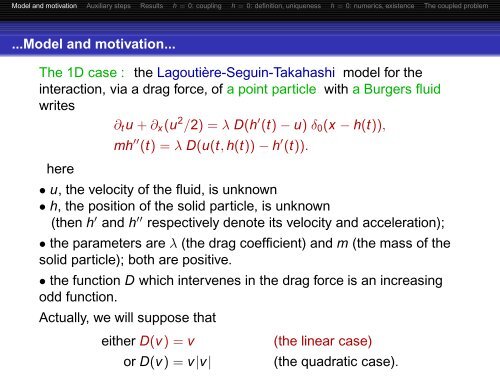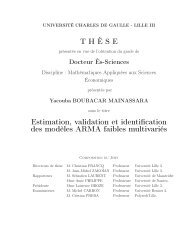A particle-in-Burgers model: theory and numerics - Laboratoire de ...
A particle-in-Burgers model: theory and numerics - Laboratoire de ...
A particle-in-Burgers model: theory and numerics - Laboratoire de ...
You also want an ePaper? Increase the reach of your titles
YUMPU automatically turns print PDFs into web optimized ePapers that Google loves.
Mo<strong>de</strong>l <strong>and</strong> motivation Auxiliary steps Results h = 0: coupl<strong>in</strong>g h = 0: <strong>de</strong>f<strong>in</strong>ition, uniqueness h = 0: <strong>numerics</strong>, existence The coupled problem<br />
...Mo<strong>de</strong>l <strong>and</strong> motivation...<br />
The 1D case : the Lagoutière-Segu<strong>in</strong>-Takahashi <strong>mo<strong>de</strong>l</strong> for the<br />
<strong>in</strong>teraction, via a drag force, of a po<strong>in</strong>t <strong>particle</strong> with a <strong>Burgers</strong> fluid<br />
writes<br />
∂tu +∂x(u 2 /2) = λ D(h ′ (t)−u) δ0(x − h(t)),<br />
here<br />
mh ′′ (t) = λ D(u(t, h(t)) − h ′ (t)).<br />
• u, the velocity of the fluid, is unknown<br />
• h, the position of the solid <strong>particle</strong>, is unknown<br />
(then h ′ <strong>and</strong> h ′′ respectively <strong>de</strong>note its velocity <strong>and</strong> acceleration);<br />
• the parameters are λ (the drag coefficient) <strong>and</strong> m (the mass of the<br />
solid <strong>particle</strong>); both are positive.<br />
• the function D which <strong>in</strong>tervenes <strong>in</strong> the drag force is an <strong>in</strong>creas<strong>in</strong>g<br />
odd function.<br />
Actually, we will suppose that<br />
either D(v) = v (the l<strong>in</strong>ear case)<br />
or D(v) = v|v| (the quadratic case).
















